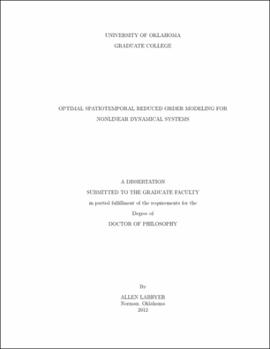| dc.contributor.advisor | Attar, Peter J||Vedula, Prakash | |
| dc.creator | LaBryer, Allen Russell | |
| dc.date.accessioned | 2019-04-27T21:33:03Z | |
| dc.date.available | 2019-04-27T21:33:03Z | |
| dc.date.issued | 2012 | |
| dc.identifier | 99288575502042 | |
| dc.identifier.uri | https://hdl.handle.net/11244/318987 | |
| dc.description.abstract | Proposed in this dissertation is a novel reduced order modeling (ROM) framework called optimal spatiotemporal reduced order modeling (OPSTROM) for nonlinear dynamical systems. The OPSTROM approach is a data-driven methodology for the synthesis of multiscale reduced order models (ROMs) which can be used to enhance the efficiency and reliability of under-resolved simulations for nonlinear dynamical systems. In the context of nonlinear continuum dynamics, the OPSTROM approach relies on the concept of embedding subgrid-scale models into the governing equations in order to account for the effects due to unresolved spatial and temporal scales. Traditional ROMs neglect these effects, whereas most other multiscale ROMs account for these effects in ways that are inconsistent with the underlying spatiotemporal statistical structure of the nonlinear dynamical system. | |
| dc.description.abstract | The OPSTROM framework presented in this dissertation begins with a general system of partial differential equations, which are modified for an under-resolved simulation in space and time with an arbitrary discretization scheme. Basic filtering concepts are used to demonstrate the manner in which residual terms, representing subgrid-scale dynamics, arise with a coarse computational grid. Models for these residual terms are then developed by accounting for the underlying spatiotemporal statistical structure in a consistent manner. These subgrid-scale models are designed to provide closure by accounting for the dynamic interactions between spatiotemporal macroscales and microscales which are otherwise neglected in a ROM. For a given resolution, the predictions obtained with the modified system of equations are optimal (in a mean-square sense) as the subgrid-scale models are based upon principles of mean-square error minimization, conditional expectations and stochastic estimation. Methods are suggested for efficient model construction, appraisal, error measure, and implementation with a couple of well-known time-discretization schemes. | |
| dc.description.abstract | Four nonlinear dynamical systems serve as testbeds to demonstrate the technique. First we consider an autonomous van der Pol oscillator for which all trajectories evolve to self-sustained limit cycle oscillations. Next we investigate a forced Duffing oscillator for which the response may be regular or chaotic. In order to demonstrate application for a problem in nonlinear wave propagation, we consider the viscous Burgers equation with large-amplitude inflow disturbances. For the fourth and final system, we analyze the nonlinear structural dynamics of a geometrically nonlinear beam under the influence of time-dependent external forcing. | |
| dc.description.abstract | The practical utility of the proposed subgrid-scale models is enhanced if it can be shown that certain statistical moments amongst the subgrid-scale dynamics display to some extent the following properties: spatiotemporal homogeneity, ergodicity, smooth scaling with respect to the system parameters, and universality. To this end, we characterize the subgrid-scale dynamics for each of the four problems. The results in this dissertation indicate that temporal homogeneity and ergodicity are excellent assumptions for both regular and chaotic response types. Spatial homogeneity is found to be a very good assumption for the nonlinear beam problem with models based upon single-point but not multi-point spatial stencils. The viscous Burgers flow, however, requires spatially heterogeneous models regardless of the stencil. For each of the four problems, the required statistical moments display a functional dependence which can easily be characterized with respect to the physical parameters and the computational grid. This observed property, in particular, greatly simplifies model construction by way of moment estimation. | |
| dc.description.abstract | We investigate the performance of the subgrid-scale models with under-resolved simulations (in space and time) and various discretization schemes. For the canonical Duffing and van der Pol oscillators, the subgrid-scale models are found to improve the accuracy of under-resolved time-marching and time-spectral simulations by one to two orders of magnitude. The models are also found to improve the reliability of predictions for both regular and chaotic response types by eliminating the onset of artificial regularity due to strong numerical damping with a coarse temporal grid. For the viscous Burgers flow and nonlinear beam problems, both subgrid spatial and temporal scales prove to be important as finite-difference-based simulations are expedited by coarsening the computational grid in space and time. For the viscous Burgers flow, the subgrid spatial and temporal models alone appear to be insufficient for error reduction, but when used in conjunction, the models are shown to improve statistical descriptions of the flow by five-fold. For the nonlinear beam, we perform a set of numerical experiments designed to capture the complex bifurcation behavior of the beam response. Maps for the Lyapunov exponents are also obtained with greater accuracy by including the subgrid-scale models. We find that a specified level of accuracy can be obtained one to two orders of magnitude faster by including the models instead of refining the computational grid. | |
| dc.format.extent | 226 pages | |
| dc.format.medium | application.pdf | |
| dc.language | en_US | |
| dc.relation.requires | Adobe Acrobat Reader | |
| dc.subject | Nonlinear systems | |
| dc.subject | Differentiable dynamical systems | |
| dc.title | Optimal Spatiotemporal Reduced Order Modeling for Nonlinear Dynamical Systems | |
| dc.type | text | |
| dc.type | document | |
| dc.thesis.degree | Ph.D. | |
| ou.group | College of Engineering::School of Aerospace and Mechanical Engineering | |
